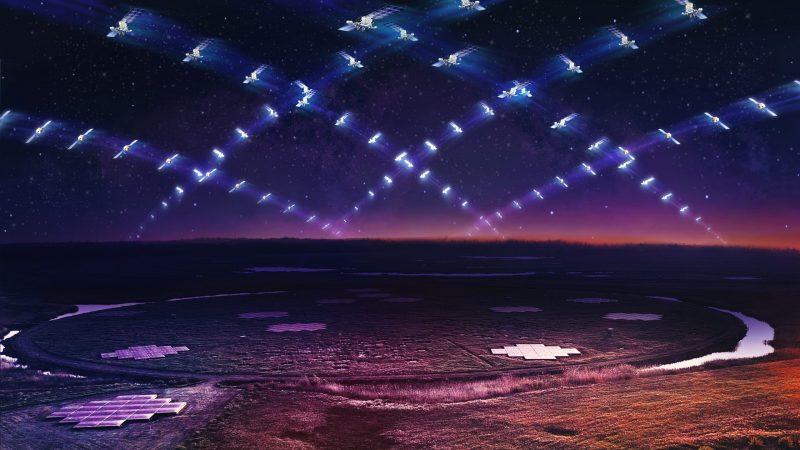
SpaceX satellites leaking radio waves
On July 5, 2023, astronomers from various institutions announced that their new study has detected “unintended electromagnetic radiation” emanating from the onboard electronics of the controversial Starlink satellites. They said this measurable leakage from the satellites – which make up SpaceX’s giant satellite constellations – might already be interfering with the science of radio astronomy.
These scientists were working under the auspices of the International Astronomical Union (IAU) Center for the Protection of the Dark and Quiet Sky from Satellite Constellation Interference (CPS).
The scientists confirmed the radiation leakage in observations made with the LOFAR telescope, a low-frequency radio array in the Netherlands.
The peer-reviewed journal Astronomy and Astrophysics accepted the study for publication on May 12, 2023.
Pretty proud of my response to this Elon fanboy in a Reddit thread about mega constellation effects on radio astronomy pic.twitter.com/GNZppDoJ5c
— Yvette Cendes (@whereisyvette) July 11, 2023
Musk’s SpaceX Starlink satellites
For the study, the scientists observed 68 Starlink satellites. While the researchers focused on Starlink satellites because they dominate the category of manmade objects in orbit around Earth, they recognize that there are other large satellite constellations. Their statement said:
The authors expect to detect similar unintended emissions from other low-Earth-orbiting satellites, and further measurement work is already planned focusing on other satellite constellations.
Lead author Federico Di Vruno of the IAU said:
This study represents the latest effort to better understand satellite constellations’ impact on radio astronomy. Previous workshops on Dark and Quiet Skies theorized about this radiation, and our observations confirm it is measurable.
Listening to the sky
Radio astronomers detect faint radio signals from the sky to learn more about dying stars, the black hole at the center of our galaxy, and much more. On Earth, radio astronomers have always had to contend with humanmade radio signals, and, as a result, have often built their telescopes in locations far from interference. In fact, there are even plans to build a radio telescope in a crater on the far side of the moon.
But it’s becoming more clear that Earth-based radio telescopes are facing a growing problem of satellite interference. While all astronomical observatories have to deal with the issue of satellites crossing the field of view of their instruments, radio astronomers say the problem is particularly acute for them.
A satellite’s radio signal is much, much stronger than the faint background sources that radio astronomers study. And a satellite doesn’t have to pass right in front of the object of study to cause interference. Satellite sources in a radio telescope’s “peripheral vision” also interfere.
But there’s more. The astronomers explained:
With many thousands of satellites in low Earth orbit, any radio telescope will have many satellites radiating signals in its view at any given time. The expectation has been that the primary source of concern from satellite constellations will be their planned communications transmissions to and from Earth.
Plus, radio telescopes aren’t only looking at dim lights in the night. They’re looking at the sky 24/7. So, satellites are a problem every hour of the day, not just at twilight.
And now they’ve confirmed there’s measurable electromagnetic radiation leaking from satellites.
How to stop satellites leaking radiation
On Earth, laws regulate how much a device’s radiation can interfere with one nearby. But for satellites, this kind of radiation isn’t subject to any international laws. Cees Bassa, a co-author from ASTRON, said:
With LOFAR, we detected radiation between 110 and 188 MHz from 47 out of the 68 satellites that were observed. This frequency range includes a protected band between 150.05 and 153 MHz specifically allocated to radio astronomy by the International Telecommunications Union (ITU).
So, in space, satellite owners aren’t breaking any laws. But the astronomers said they would like to work with satellite operators and regulators to address this impact. In fact, the astronomers are already working with SpaceX. The spaceflight company has introduced some mitigation devices to their next generation of satellites. Co-author Gyula Józsa of the Max Planck Institute for Radio Astronomy and Rhodes University said:
We believe that the early recognition of this situation gives astronomy and large constellation operators an opportunity to work together on technical mitigations proactively, in parallel to the necessary discussions to develop suitable regulations.
The future of expanding satellite constellations
According to the IAU Center for the Protection of Dark and Quiet Skies, there are currently 4,276 operational constellation satellites orbiting Earth. While that may sound like a lot, there are 427,171 planned constellation satellites. So the problem will only get worse. Benjamin Winkel from the Max Planck Institute for Radio Astronomy said:
Our simulations show that the larger the constellation, the more important this effect becomes as the radiation from all the satellites adds up. This makes us worried not only about the existing constellations but even more about the planned ones … and also about the absence of clear regulation that protects the radio astronomy bands from unintended radiation.
Here’s hoping the budding teamwork between scientists and satellite operators will be a bright step toward darker and quieter skies.
Bottom line: A new study confirms that 68 satellites are leaking radio waves that might harm radio astronomers’ observations of the universe. Astronomers are worried.











